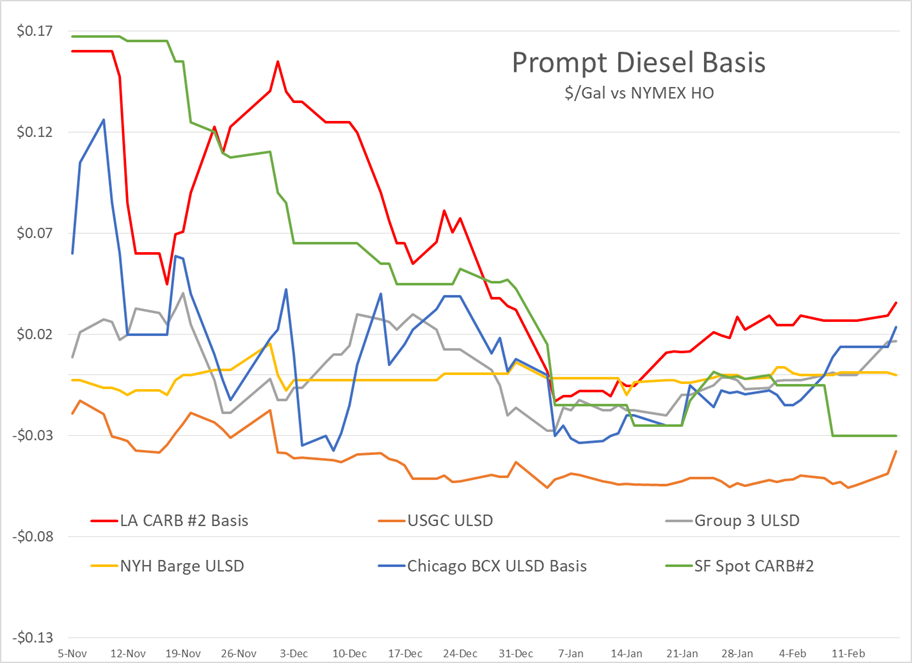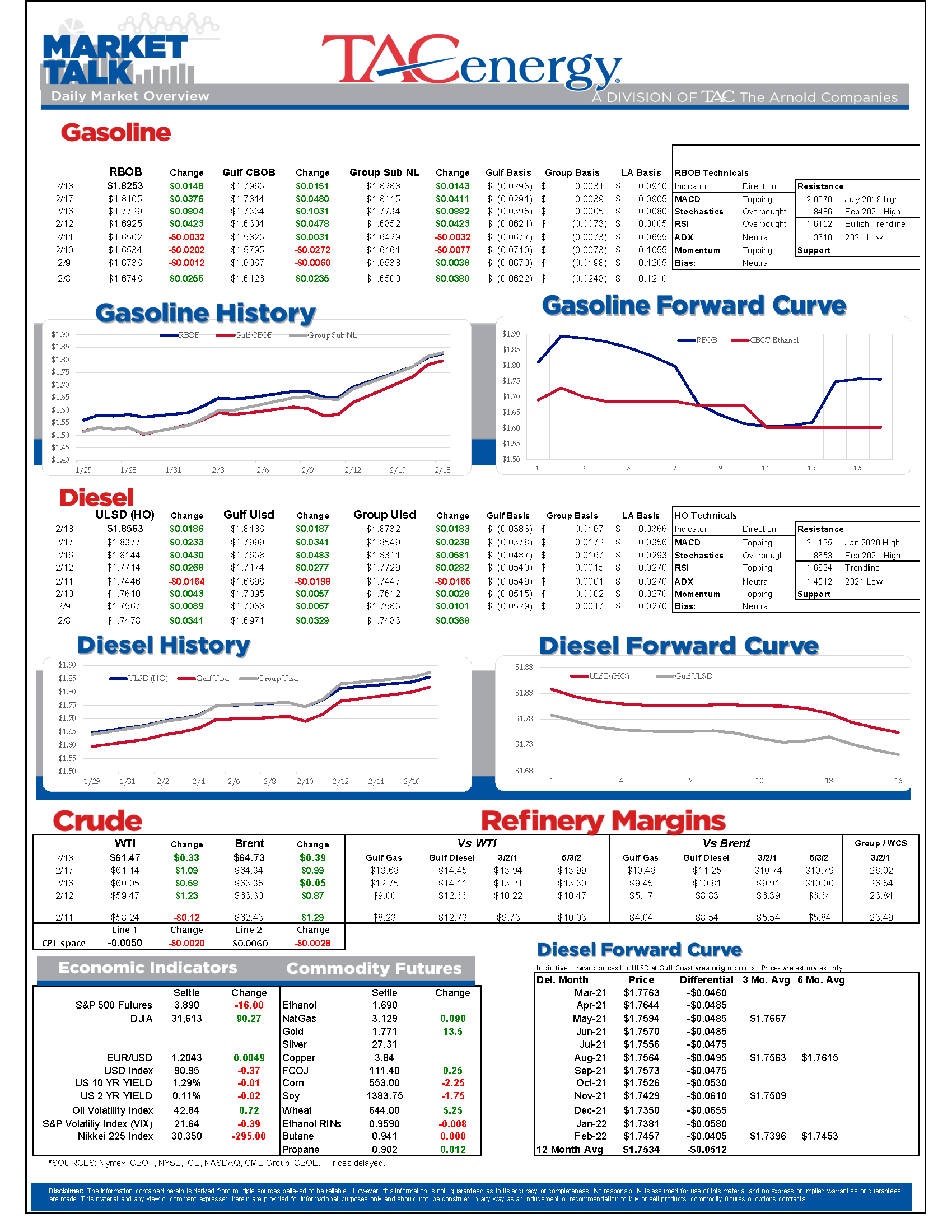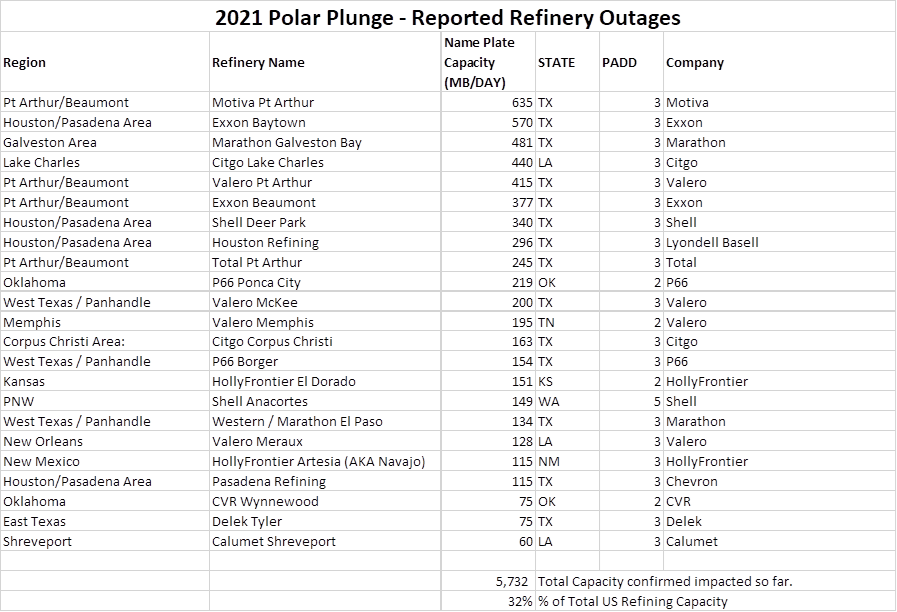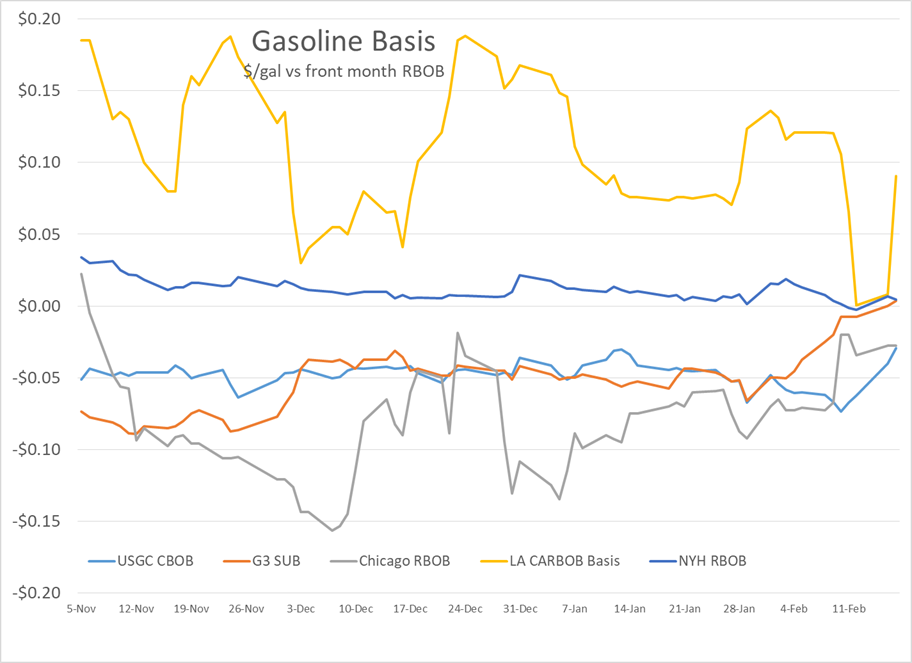How Long Until Power Comes Back On?

How long until the power comes back on? That’s the big question being asked by millions of people across the U.S. and Mexico, and a huge proportion of the energy industry as the remnants of a brutal stretch of winter weather moves East, and the thawing out process begins. In addition to the direct impact, the trickle down effects of the collapse in oil, refined products, natural gas and ethylene production are being felt around the world.
The refining hubs along the Gulf Coast from Corpus Christi to New Orleans have temperatures above freezing this morning, and should stay that way for the next week, except for a few hours tonight. If that thaw allows most plants to resume operations by the weekend, the impact of this chaotic event should be short-lived. Of course, the warm up also means that more drivers are about to hit the road, while terminals and stations that have been closed for a few days may or may not be able to come back online with supply, power and/or intact pipes to meet demand.
If you remember the panic buying in the wake of Hurricane Harvey, it’s not hard to imagine that the next few days could create a demand spike as news of the refinery shutdowns hits the mainstream just in time for people to start leaving their homes again, and could create a preventable panic phenomenon which could create supply shortages all on its own.
The Houston ship channel was able to resume limited operations after the ice blocking shipping lanes started to break up, a most unusual occurrence that may have some Texans reluctant to use the phrase “When Hell Freezes over” ever again.
We did see some heavy selling for about an hour Wednesday morning after a WSJ report that said Saudi Arabia was going to increase its oil output now that prices had recovered. That wave of selling wiped out the early gains for crude and product futures, but was fairly short lived and the march higher picked up later in the morning.
Basis markets continue to show strength for both gasoline and diesel grades across most U.S. spot markets, but those moves are still relatively minor compared to disruptions we’ve witnessed over the past two decades, a testament to the excess capacity in the U.S. and the softer-than-normal demand environment. In addition to stronger spot prices, numerous rack markets stretching from Arizona to Maryland have switched from seeing suppliers having to offer steep discounts to move product during the winter doldrums, to enforcing strict allocations as resupply options become questionable.
The API reported large draws in oil and diesel stocks last week, while gasoline stocks had another large build. The DOE’s weekly report is due out at 10 a.m. central today, and should give some glimpse into the impact on gasoline demand caused by the winter storms that battered the East Coast two weeks ago, that now appear quaint in comparison. Don’t expect the report to move the market much as last Friday’s data doesn’t mean much after almost 1/3 of the country’s refining capacity was forced to cut back this week.
In other non-frozen refinery news this week, Calumet laid out plans to convert part of its Great Falls Montana facility to Renewable Diesel production this week in an SEC filing, joining a long list of refiners looking to jump on the BTC/RIN/LCFS and new Canadian CFS programs that combined can offer more than $4.50/gallon in subsidies for RD production. The company also closed on the sale and leaseback of its Shreveport facility in an effort to save enough cash to survive the weak margin environment that was hammering refineries before the storms hit.
Great Falls Renewable Diesel Opportunity:
We believe Great Falls, which connects western agriculture with West Coast and Canadian clean product markets, presents one of the most compelling opportunities for Renewable Diesel production in North America. We estimate the oversized hydrocracker built in 2016 can be reconfigured to process 10-12,000 BPD renewable feedstock at the lowest capital cost per barrel of any announced industry project. Hydrocracker conversions are typically faster to market, cheaper, and less technically challenging. In addition, the planned configuration could retain 10-12,000 BPD low-cost Canadian crude processing, providing Montana customers with clean energy and our unique specialty asphalt. Future dual train operations are currently estimated to generate $220 to $260 million of Adjusted EBITDA assuming mid-cycle market prices and existing environmental market structure (BTC, RINs, LCFS).
Given strong investor interest in renewables, Calumet expects to utilize third party equity for this unique opportunity, without expending Calumet funds.
Click here to download a PDF of today's TACenergy Market Talk.
Latest Posts
Week 16 - US DOE Inventory Recap
Energy Markets Trading Quietly In The Red As Ethanol Prices Rally To Five-Month High
The Struggle For Renewable Producers Continues As A Rapid Influx Of Supply And Crashing Credit Prices Make Biodiesel
After Years Of Backwardation, Diesel Prices Have Slipped Into Contango Over The Past Week
Social Media
News & Views
View All
Week 16 - US DOE Inventory Recap

Energy Markets Trading Quietly In The Red As Ethanol Prices Rally To Five-Month High
Energy markets are trading quietly in the red to start Wednesday’s session after a healthy bounce Tuesday afternoon suggested the Israel-Iran-linked liquidation had finally run its course.
There are reports of more Ukrainian strikes on Russian energy assets overnight, but the sources are sketchy so far, and the market doesn’t seem to be reacting as if this is legitimate news.
Ethanol prices have rallied to a 5-month high this week as corn and other grain prices have rallied after the latest crop progress update highlighted risks to farmers this year, lower grain export expectations from Ukraine, and the approval of E15 blends this summer despite the fact it pollutes more. The rally in grain and renewables prices has also helped RIN values find a bid after it looked like they were about to test their 4-year lows last week.
The API reported small changes in refined product inventories last week, with gasoline stocks down about 600,000, while distillates were up 724,000. Crude oil inventories increased by 3.2 million barrels according to the industry-group estimates. The DOE’s weekly report is due out at its normal time this morning.
Total reported another upset at its Port Arthur refinery that’s been a frequent flier on the TCEQ alerts since the January deep freeze knocked it offline and damaged multiple operating units. This latest upset seems minor as the un-named unit impacted was returned to normal operations in under an hour. Gulf Coast basis markets have shrugged off most reports of refinery upsets this year as the region remains well supplied, and it’s unlikely we’ll see any impact from this news.
California conversely reacted in a big way to reports of an upset at Chevron’s El Segundo refinery outside of LA, with CARBOB basis values jumping by more than a dime. Energy News Today continued to show its value by reporting the upset before the flaring notice was even reported to area regulators, proving once again it’s ahead of the curve on refinery-related events. Another industry news outlet meanwhile struggled just to remember where the country’s largest diesel seller is located.
Click here to download a PDF of today's TACenergy Market Talk

The Struggle For Renewable Producers Continues As A Rapid Influx Of Supply And Crashing Credit Prices Make Biodiesel
The sigh of relief selloff continues in energy markets Tuesday morning, with gasoline prices now down more than 20 cents in 7 sessions, while diesel prices have dropped 26 cents in the past 12. Crude oil prices are within a few pennies of reaching a 1 month low as a lack of headlines from the world’s hot spots allows some reflection into the state of the world’s spare capacity for both oil and refined products.
Gasoline prices are trading near a 6-week low this morning, but still need to fall about another nickel in order to break the weekly trendline that pushed prices steadily higher since December. If that trend breaks, it will be safer to say that we saw the end of the spring gasoline rally on April 12th for the 2nd year in a row. Last year RBOB futures peaked on April 12 at $2.8943 and bottomed out on May 4th at $2.2500. The high (at this point) for this year was set on April 12th at $2.8516, and the low overnight was $2.6454.
It’s not just energy commodities that are seeing an unwind of the “flight to safety” trade: Gold prices had their biggest selloff in 2 years Monday and continue to point lower today. Just how much money poured into commodities in the weeks leading up to the direct confrontation between Israel and Iran is unclear, but we have seen in year’s past that these unwind-events can create a snowball effect as traders can be forced to sell to cover their margin calls.
Supply > Demand: The EIA this morning highlighted the record setting demand for natural gas in the US last year, which was not nearly enough to offset the glut of supply that forced prices to a record low in February. A shortage of natural gas in Europe was a key driver of the chaotic markets that smashed just about every record in 2022, and an excess of natural gas supply in Europe and the US this year is acting as a buffer, particularly on diesel prices.
The struggle for renewable producers continues as a rapid influx of supply and crashing credit prices make Biodiesel, RD and SAF unprofitable for many. In addition to the plant closures announced in the past 6 months, Vertex Energy reported Monday it’s operating its Renewable Diesel facility in Mobile AL at just 50% of capacity in Q1. The truly scary part for many is that the $1/gallon Blender's tax credit ends this year and is being replaced by the “Clean” Fuel production credit that forces producers to prove their emissions reductions in order to qualify for an increased subsidy. It’s impossible to say at this point how much the net reduction will be for domestic producers, but importers will get nothing, and at current CI values, many biodiesel producers may see their “blend credit” cut by more than half.
Click here to download a PDF of today's TACenergy Market Talk.



